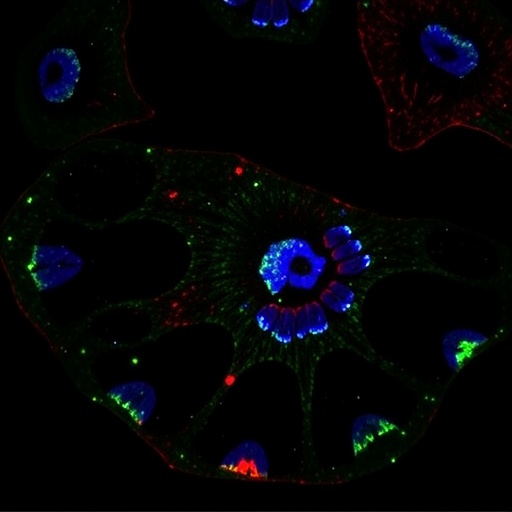In a groundbreaking exploration of the intersection between psychological disorders, a recent case study sheds light on the intricate therapeutic processes involved in treating patients battling both Anorexia Nervosa (AN) and Complex Post-Traumatic Stress Disorder (C-PTSD). The study chronicles the experiences of an out-patient individual whose treatment journey unfolds under the skilled guidance of mental health professionals. This case report, penned by renowned researchers Moyo, Stenvall, and Brinchmann, delves deeply into the mechanisms of healing and the nuanced understanding required to tackle such multifaceted disorders concurrently.
Understanding the complex interplay between AN and C-PTSD is paramount in this investigation. Anorexia Nervosa is primarily characterized by an intense fear of gaining weight and a distorted body image, often leading to severe self-starvation and potentially life-threatening consequences. C-PTSD, on the other hand, emerges from prolonged trauma exposure and is marked by recurrent recollections of trauma, emotional dysregulation, and significant impairments in interpersonal functioning. When these two conditions coalesce, the therapeutic challenges multiply, necessitating an innovative and tailored approach to treatment.
The authors of the study detail how traditional therapeutic approaches can fall short when addressing the profound shame and distress inherent in both conditions. Merely addressing one disorder without recognizing the impact of the other can lead to incomplete recovery and repeated cycles of relapse. This revelation underscores the importance of an integrative therapeutic framework that prioritizes the individual’s unique experiences while employing evidence-based practices designed to treat both AN and C-PTSD simultaneously.
Central to the therapeutic process described in the case study is the utilization of a trauma-informed care approach. This model emphasizes understanding the patient’s background, particularly their traumas, and how those traumas manifest in their eating behaviors and self-perception. The therapists create a safe space where the individual feels secure enough to explore their feelings surrounding food, body image, and trauma without judgment. This empathetic environment is a crucial factor in fostering trust, which is essential for healing.
The case also highlights the importance of Emotion-Focused Therapy (EFT) as a key component in the patient’s journey toward recovery. EFT facilitates emotional awareness and regulation, encouraging individuals to access, experience, and process difficult emotions that often underpin their behaviors associated with both AN and C-PTSD. Through this modality, patients learn to restructure their relationship with their emotions, reducing the distress that drives maladaptive coping mechanisms such as disordered eating.
In addition to these psychotherapeutic techniques, the researchers emphasize the role of nutritional rehabilitation in the treatment process. Providing education about nutrition and the physiological processes of the body can help demystify some of the fears surrounding food and weight gain. This educational component serves to empower patients, equip them with the knowledge to make informed decisions regarding their health, and diminish the control that their disorders exert over them.
The rapport between the patient and therapist emerges as another significant theme in the report. Establishing a strong therapeutic alliance can lead to improved treatment outcomes, particularly in cases involving complex disorders. The researchers note that the relationship should be characterized by mutual respect, understanding, and collaboration, allowing the patient to feel actively involved in their treatment plan. This partnership is not only empowering for the individual but also essential for the therapist to adequately understand the patient’s unique lived experience.
As the case progresses, the study documents notable improvements in the patient’s psychological resilience and eating behaviors. The integration of therapeutic modalities allows for a more comprehensive understanding of the underlying issues. For example, through cognitive restructuring aimed at challenging and modifying unhealthy thought patterns related to body image, the patient begins to cultivate a healthier self-concept.
Interestingly, the authors outline how self-compassion emerges as an integral focus of the therapeutic journey. Building a kind and forgiving relationship toward oneself can significantly alter one’s mental landscape, helping to reduce the pervasive self-criticism that is often seen in both AN and C-PTSD. Through various exercises designed to enhance self-compassion, patients can develop a more balanced perspective of their worth, independent of their eating habits or traumatic experiences.
Moreover, group therapy sessions, as explored in the study, provide a vital support network for individuals facing similar challenges. These sessions allow patients to share their experiences, fostering a sense of belonging and understanding that can be profoundly healing. Peer interactions reinforce resilience and provide validation, aiding in the dismantling of the feelings of isolation that frequently accompany both conditions.
The collaborative effort among healthcare providers is also underscored as a critical component in the success of the therapeutic process. By working in tandem, nutritionists, psychologists, and psychiatrists can ensure that the individual receives holistic care tailored to their specific needs. This interdisciplinary approach not only streamlines the treatment process but also enriches the therapeutic experience for the patient.
Overall, the case study illustrates that the journey through comorbid AN and C-PTSD is neither linear nor predictable; instead, it is filled with setbacks, triumphs, and complex emotions. As the patient navigates this challenging path, the interplay of therapy modalities and supportive measures create a multifaceted framework that addresses the profound intricacies of their experience.
As mental health research continues to evolve, this case serves as a poignant reminder of the importance of individualized care in treating complex psychiatric disorders. For the therapeutic community, the findings underline the need for ongoing education, innovative practices, and a commitment to understanding the layered experiences of patients facing comorbidity. The insights gained from this case report will undoubtedly contribute to future advancements in treatment protocols, marking a significant step forward in the quest to foster recovery among individuals grappling with these debilitating conditions.
Ultimately, the case sheds light on the resilience of the human spirit and the capacity for recovery, leaving readers with a sense of hope. The path may be fraught with challenges, but with the right support and an understanding of the therapeutic processes at play, healing is not only possible but achievable.
Subject of Research: Comorbid Anorexia Nervosa and Complex Post-Traumatic Stress Disorder Treatment
Article Title: “We went fishing in the dark”: a case report highlighting one therapeutic process in an out-patient comorbid anorexia nervosa (AN) and complex post-traumatic stress disorder (C-PTSD) treatment.
Article References:
Moyo, K.R., Stenvall, B.J. & Brinchmann, B.S. “We went fishing in the dark”: a case report highlighting one therapeutic process in an out-patient comorbid anorexia nervosa (AN) and complex post-traumatic stress disorder (C-PTSD) treatment. J Eat Disord 13, 178 (2025). https://doi.org/10.1186/s40337-025-01352-5
Image Credits: AI Generated
DOI: 10.1186/s40337-025-01352-5
Keywords: Anorexia Nervosa, Complex Post-Traumatic Stress Disorder, Therapy, Trauma-Informed Care, Emotion-Focused Therapy, Nutritional Rehabilitation, Self-Compassion, Interdisciplinary Approach.
Tags: anorexia nervosa treatmentComplex Post-Traumatic Stress Disorder therapycoping with shame in mental healthdual diagnosis therapeutic approachesemotional dysregulation in eating disordershealing mechanisms for AN and C-PTSDinnovative treatment strategies for complex disordersinterdisciplinary approaches to mental health treatmentmental health professionals guidancepatient experiences in dual diagnosis treatmentpsychological disorders intersectiontrauma-informed care for anorexia





